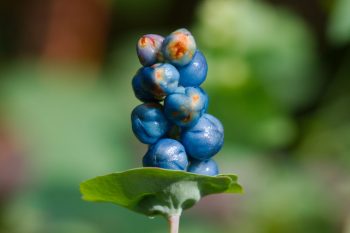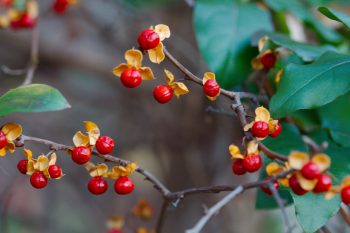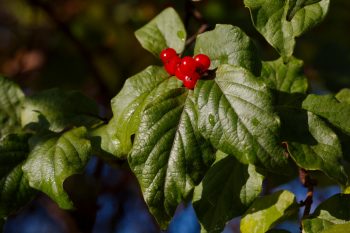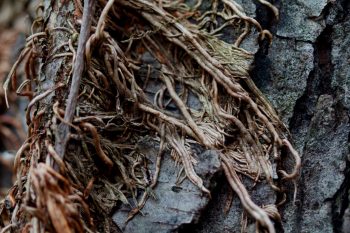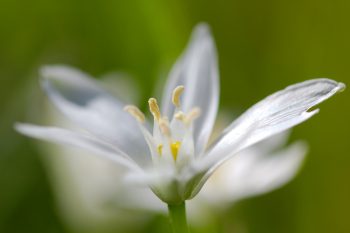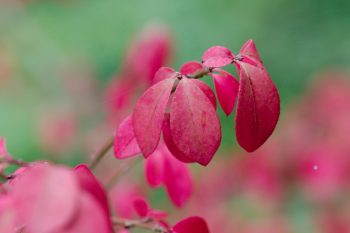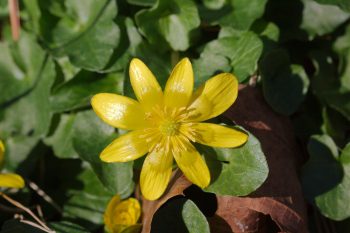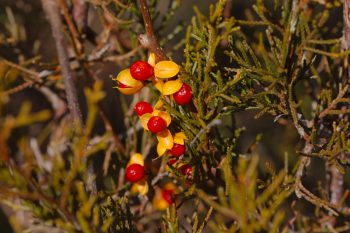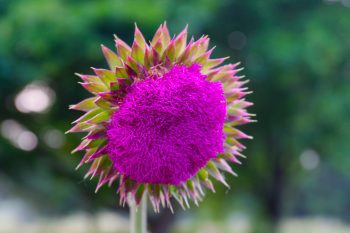Mile-a-minute vine, also known as devil’s tail and tearthumb, is an herbaceous annual vine in the buckwheat family. If you’ve ever encountered it you will know where the name tearthumb comes from. It is native to Asia but has become naturalized throughout the area and is a serious pest. Think of bindeed on steroids and with seriously barbed stems but without interesting flowers. It does have interesting fruit, I have to admit. These little berries are less that 5mm across but they are such a clear, beautiful blue, I cannot help but enjoy them. That’s not to say I would ever consider growing this for the ornamental value of the berries, of course. But they are still pretty.
Tagged With: Invasive
Mile-a-Minute Vine (Polygonum perfoliatum)
Oriental Bittersweet (Celastrus orbiculatus)
Cathy and I went for a walk near Lake Frank today, parking on Bauer Drive and walking in through a break in the houses (there’s a lot that’s not privately owned) and then along the road that leads, within the park, the the parking area. That road and parking area are not in use and haven’t been for many years although I’m not entirely sure why. It was a pleasant walk and we enjoyed the late autumn colors reflected in the lake as well as the oriental bittersweet (Celastrus orbiculatus) in a few places. I don’t recommend growing this, but I have to admit it’s pretty.
Lonicera maackii (Amur Honeysuckle)
This is one of the more prevalent weed shrubs in our area. The Amur honeysuckle (Lonicera maackii) is an east Asian native that has firmly established itself as noxious weed in the eastern half of North America. It’s got the sweet, tubular flowers typical to honeysuckles, starting out white and aging to yellow. They are followed in the fall (right about now, obviously) by bright red, juicy berries. Although they are inedible to humans, birds eat them and spread the seeds far and wide. They were once planted as an ornamental and you can see why. However, they are no longer recommended, because of their invasive nature.
Ivy Roots
There are places where English ivy (Hedera helix) looks really nice. It’s also a very good ground cover for many situations. Nevertheless, I’m not a huge fan. In a city, where it can perhaps be contained reasonably well by paving, etc., it’s suitable. In the suburbs and rural areas it can really be an annoyance. This ivy is growing up a tree near my office and you can see how it grips its host. It will grow up into the tallest trees and eventually strangle them. It also covers the ground so completely that in often chokes out less aggressive plants (and there are only a few more aggressive). We’ve done our best to eliminate it from our yard and with a small patch that seems to reappear occasionally, we’ve succeeded. But we remain on DEFCON 3 or higher.
Ornithogalum umbellatum (Star of Bethlehem)
The Star of Bethlehem (Ornithogalum umbellatum) is a pretty, little, but invasive bulbous plant native to Europe, northern Africa, and the Middle East. It’s coming up in our back yard and we really should do something about it, although it’s hard to want to pull out something as pretty as this. I’m not sure where it came from as we only have it growing in our lawn and not in any of our garden beds. This time of year they just appear in the lawn. Our mower is out of commission until I get a new carburetor so the grass is getting long but once that’s running again, these will be mowed along with the grass.
Burning Bush (Euonymus alatus)
As a landscape plant, burning bush (Euonymus alatus) can be quite striking. I hesitate to ever recommend it. It is an invasive and its use is actively discouraged in many areas (and even banned in Massachusetts, I believe). It’s a native of northeastern Asia and is naturalized over much of eastern North America. The plant we have is in a pot, which helps keep it small, although I’m not really sure I want even that much in my yard. Not that getting rid of ours is going to make much difference, as this is grown all over our area and the cat is already out of the bag.
Ficaria verna
Dorothy, Cathy, and I walked on the Seneca Greenway Trail this afternoon, parking where MD 28 crosses Seneca Creek and walking downstream. We only saw a few other people and it was a very pleasant walk. It’s relatively flat, with only a few ups and downs to deal with. The birds were out in force and we heard them all around, although we weren’t stopping to see them so much and didn’t really get very close to any. I did stop to take a few photos, including of this fig buttercup, also known as lesser celandine. It was formerly classified as Ranunculus ficaria but is now Ficaria verna. It’s an invasive, non-native species that grows in many of our wetlands.
Celastrus orbiculatus (Asian Bittersweet)
Cathy and I went for another walk after church today (that’s pretty common, as you might have noticed). This time we went to the Blue Mash Trail on Zion Road behind the Laytonsville land fill. I didn’t take many pictures and most of them were of Asiatic bittersweet (Celastrus orbiculatus) as in this photo. I particularly like this picture because of the added color of the juniper (most likely eastern red cedar, Juniperus virginiana). We have a native bittersweet (Celastrus scandens) but I’ll confess that I could not readily differentiate between the two, basically assuming that anything we see is the more aggressive C. orbiculatus.
Carduus nutans (Musk Thistle)
The musk thistle (Carduus nutans), also commonly known as the nodding or nodding plumeless thistle, is an invasive species introduced into the United States around the middle of the 19th century. It has now spread to all of the lower 48 states (with the possible exceptions of Florida, Vermont, and Maine, although I wouldn’t be surprised if it’s there, as well) and the lower provinces of Canada from British Columbia to Newfoundland. It’s a rather tall and somewhat striking plant with a large, and as you can see showy bloom. It is usually a biennial but in warmer climates can flower in its first year. Rather than there being single, large flowers, each of the purple threads in the flowerhead is technically a separate flower.

